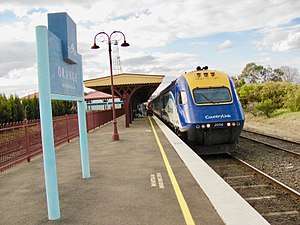Orange, New South Wales
Orange is a city in the Central Tablelands region of New South Wales, Australia. It is 254 km (158 mi) west of the state capital, Sydney [206 km (128 mi) on a great circle],[3] at an altitude of 862 metres (2,828 ft). Orange had an estimated urban population of 40,493[1] as of June 2018 making the city a significant regional centre. A significant nearby landmark is Mount Canobolas with a peak elevation of 1,395 m (4,577 ft) AHD and commanding views of the district.
| Orange New South Wales | |||||||||
|---|---|---|---|---|---|---|---|---|---|
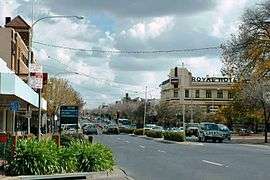 The main street of Orange, Summer Street, as viewed from the vicinity of McNamara Street looking west in May 2008 | |||||||||
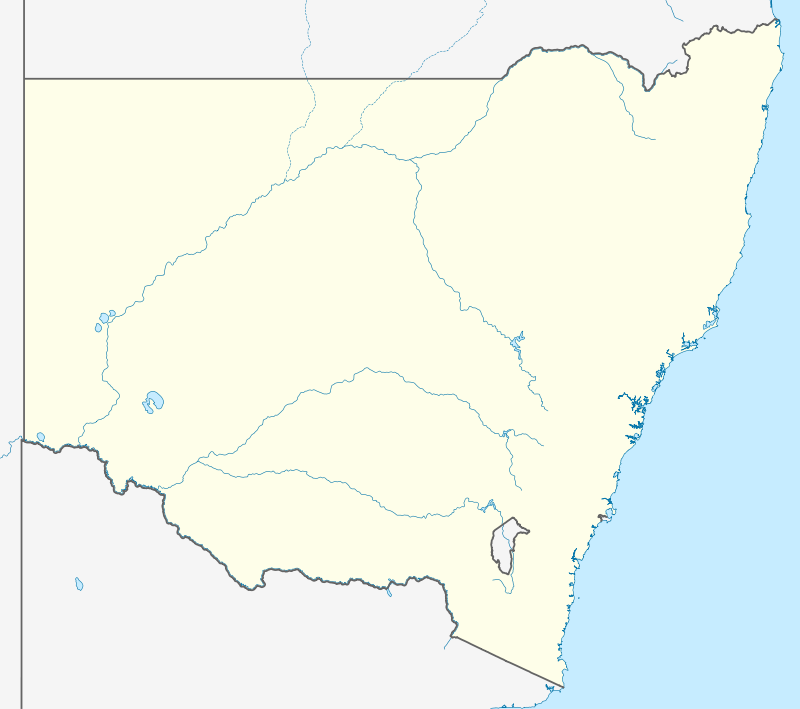 Orange | |||||||||
| Coordinates | 33°17′0″S 149°06′0″E | ||||||||
| Population | 40,493 (2018)[1] (10th in NSW) | ||||||||
| Established | 1846 | ||||||||
| Postcode(s) | 2800 | ||||||||
| Elevation | 863.2 m (2,832 ft)[2] | ||||||||
| Location | |||||||||
| LGA(s) | City of Orange | ||||||||
| Region | Central West (New South Wales) | ||||||||
| County | Wellington, Bathurst | ||||||||
| State electorate(s) | Orange | ||||||||
| Federal Division(s) | Calare | ||||||||
| |||||||||
Orange is the birthplace of poets Banjo Paterson and Kenneth Slessor, although Paterson lived in Orange for only a short time as an infant. Walter W. Stone, book publisher (Wentworth Books) and passionate supporter of Australian literature, was also born in Orange. The first Australian Touring Car Championship, known today as V8 Supercar Championship Series, was held at the Gnoo Blas Motor Racing Circuit in 1960.[4]
History
.jpg)
In 1822 Captain Percy Simpson marched into the Wellington District and established a convict settlement which was called "Blackman's Swamp" after James Blackman; Simpson had employed James Blackman as a guide because he had already accompanied an earlier explorer, John Oxley into that region.[5]
In the late 1820s, the surveyor J. B. Richards worked on a survey of the Macquarie River below Bathurst and also of the road to Wellington. On a plan dated 1829, he indicated a village reserve, in the parish of Orange. Sir Thomas Mitchell named the parish Orange, as he had been an associate of the Prince of Orange in the Peninsular War, when both were aides-de-camp to the Duke of Wellington, whose title was bestowed on the valley to the west by Oxley.[6]
Initial occupation by British graziers began in late 1829, and tiny settlements eventually turned into larger towns as properties came into connection with the road. In 1844, the surveyor Davidson was sent to check on encroachments onto the land reserved for a village, and to advise on the location for a township. His choices were Frederick's Valley, Pretty Plains, or Blackman's Swamp.
Blackman's Swamp was chosen, and it was proclaimed a village and named Orange by Major Thomas Mitchell in 1846 in honour of Prince William of Orange. At nearby Ophir, a significant gold find in Australia was made in 1851, resulting in a sporadic population movement which is known as the Australian gold rush. Additional gold finds in nearby areas led to the establishment of Orange as a central trading centre for the gold.
The growth of Orange continued as the conditions were well suited for agriculture, and in 1860 it was proclaimed a municipality. The railway from Sydney reached Orange in 1877. In 1946, 100 years after it was first being established as a village, Orange was proclaimed as a minor city.
Population
According to the 2016 census of Population, there were 37,182 people in the Orange urban centre.
- Aboriginal and Torres Strait Islander people made up 6.6% of the population.
- 83.2% of people were born in Australia. The next most common countries of birth were England 1.6%, India 1.0%, New Zealand 0.9%, Philippines 0.5% and China 0.4%.
- 87.3% of people only spoke English at home. Other languages spoken at home included Malayalam 0.7%, Mandarin 0.4%, Italian 0.3% and Nepali 0.3%.
- The most common responses for religion were Catholic 30.1%, No Religion 22.0% and Anglican 20.2%.
- Of the employed people in Orange (Urban Centres and Localities), 6.2% worked in hospitals (except psychiatric hospitals). Other major industries of employment included gold ore mining 4.2%, state government administration 3.4%, other social assistance services 3.2% and supermarket and grocery Stores 2.5%.
Geography and climate
Owing to its altitude, Orange has a temperate oceanic climate (Köppen Cfb), with warm summers (though with cool mornings) and cool winters with frequent morning frosts and light to moderate, sometimes heavy snowfalls. The city is relatively wet for an inland location owing to orographic effects from Mount Canobolas, especially during the cooler months when snow falls; Orange is amongst the few cities in Australia to receive regular snowfall, and is likewise the snowiest city in Australia (not counting smaller towns such as Oberon). Compared with most population centres in Australia it has colder winters, especially in terms of its daytime maximum temperatures, owing chiefly to its south-westerly exposure. In summer, the average (and absolute) maximum temperatures are also lower than in most inland centres, on account of its elevation.[7] Owing to its inland location, the humidity is low in the summer months with the dewpoint typically around 10 °C. Having 99.8 clear days annually,[8] it is still cloudier than the coastal areas of Sydney and Wollongong (104 and 107 clear days, respectively), with a marked lack of sunshine in winter compared to summer[9][10] The climate has enabled the area to be a major apple and pear producer, and more recently a centre for cool-weather wine production.[11]
| Climate data for Orange Airport | |||||||||||||
|---|---|---|---|---|---|---|---|---|---|---|---|---|---|
| Month | Jan | Feb | Mar | Apr | May | Jun | Jul | Aug | Sep | Oct | Nov | Dec | Year |
| Record high °C (°F) | 38.6 (101.5) |
40.1 (104.2) |
33.0 (91.4) |
29.8 (85.6) |
22.0 (71.6) |
18.5 (65.3) |
17.8 (64.0) |
20.4 (68.7) |
25.6 (78.1) |
30.7 (87.3) |
35.6 (96.1) |
38.9 (102.0) |
40.1 (104.2) |
| Average high °C (°F) | 26.0 (78.8) |
25.2 (77.4) |
22.4 (72.3) |
18.3 (64.9) |
13.9 (57.0) |
10.4 (50.7) |
9.3 (48.7) |
10.7 (51.3) |
13.7 (56.7) |
17.3 (63.1) |
20.5 (68.9) |
23.9 (75.0) |
17.6 (63.7) |
| Average low °C (°F) | 12.2 (54.0) |
12.3 (54.1) |
9.6 (49.3) |
6.2 (43.2) |
3.6 (38.5) |
1.5 (34.7) |
0.7 (33.3) |
1.4 (34.5) |
3.3 (37.9) |
5.8 (42.4) |
7.9 (46.2) |
10.1 (50.2) |
6.2 (43.2) |
| Record low °C (°F) | 1.7 (35.1) |
2.4 (36.3) |
−0.5 (31.1) |
−3.5 (25.7) |
−6.6 (20.1) |
−6.5 (20.3) |
−7.1 (19.2) |
−5.8 (21.6) |
−6.0 (21.2) |
−3.0 (26.6) |
−1.0 (30.2) |
−1.0 (30.2) |
−7.1 (19.2) |
| Average precipitation mm (inches) | 84.0 (3.31) |
82.4 (3.24) |
53.7 (2.11) |
52.6 (2.07) |
62.5 (2.46) |
66.2 (2.61) |
88.2 (3.47) |
93.6 (3.69) |
79.0 (3.11) |
78.2 (3.08) |
76.0 (2.99) |
78.8 (3.10) |
895.1 (35.24) |
| Average rainy days | 8.7 | 8.2 | 7.2 | 7.2 | 10.1 | 12.4 | 13.7 | 13.5 | 11.6 | 10.8 | 10.3 | 9.0 | 122.7 |
| Average afternoon relative humidity (%) | 44 | 49 | 51 | 55 | 63 | 70 | 70 | 65 | 61 | 56 | 53 | 45 | 57 |
| Source: [8] | |||||||||||||
| Climate data for Orange Agricultural Institute | |||||||||||||
|---|---|---|---|---|---|---|---|---|---|---|---|---|---|
| Month | Jan | Feb | Mar | Apr | May | Jun | Jul | Aug | Sep | Oct | Nov | Dec | Year |
| Record high °C (°F) | 37.2 (99.0) |
39.2 (102.6) |
33.3 (91.9) |
29.4 (84.9) |
21.6 (70.9) |
18.0 (64.4) |
16.5 (61.7) |
21.8 (71.2) |
25.7 (78.3) |
31.3 (88.3) |
36.0 (96.8) |
35.0 (95.0) |
39.2 (102.6) |
| Average high °C (°F) | 26.5 (79.7) |
25.9 (78.6) |
22.7 (72.9) |
18.5 (65.3) |
14.2 (57.6) |
10.6 (51.1) |
9.5 (49.1) |
11.1 (52.0) |
14.1 (57.4) |
17.8 (64.0) |
21.3 (70.3) |
24.6 (76.3) |
18.1 (64.6) |
| Average low °C (°F) | 13.3 (55.9) |
13.2 (55.8) |
10.7 (51.3) |
7.2 (45.0) |
4.6 (40.3) |
2.6 (36.7) |
1.5 (34.7) |
2.1 (35.8) |
4.2 (39.6) |
6.6 (43.9) |
9.2 (48.6) |
11.2 (52.2) |
7.2 (45.0) |
| Record low °C (°F) | 1.0 (33.8) |
2.8 (37.0) |
1.0 (33.8) |
−1.6 (29.1) |
−4.0 (24.8) |
−5.0 (23.0) |
−5.6 (21.9) |
−4.2 (24.4) |
−5.4 (22.3) |
−2.0 (28.4) |
−0.4 (31.3) |
0.5 (32.9) |
−5.6 (21.9) |
| Average precipitation mm (inches) | 87.1 (3.43) |
75.1 (2.96) |
64.7 (2.55) |
53.0 (2.09) |
67.6 (2.66) |
74.3 (2.93) |
90.3 (3.56) |
95.0 (3.74) |
80.1 (3.15) |
79.9 (3.15) |
76.2 (3.00) |
80.6 (3.17) |
923.9 (36.39) |
| Source 1: [12] | |||||||||||||
| Source 2: [13] | |||||||||||||
Industries
Orange is a well-known fruit growing district, and produces apples, pears, and many stone fruits such as cherries, peaches, apricots, and plums; oranges are not grown in the area, since its climate is too cool. In recent years, a large number of vineyards have been planted in the area for rapidly expanding wine production. The growth of this wine industry, coupled with the further development of Orange as a gourmet food capital, has ensured Orange's status as a prominent tourism destination.
Other large industries include:
- Cadia gold mine is a large open cut gold and copper mine located about 20 kilometres south of Orange. The mine has been developed throughout the 1990s and is a major employer in the region with an expected lifespan of several decades. Cadia is the second largest open-cut mine in Australia, following the Super Pit at Kalgoorlie, Western Australia. Large mineral deposits are also being uncovered from the more recently developed Ridgeway underground mine which is adjacent to the Cadia Mine.
- An Electrolux white goods factory, closed in 2017.
Orange is also the location of the headquarters of the New South Wales Department of Industry (Department of Industry, Skills and Regional Development, the New South Wales Department of Primary Industries).
Education
Primary and public schools
|
|
|
The following primary schools are not within the city limits of Orange but are located within the rural fringe of Orange:
|
|
|
Secondary schools
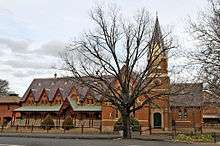
- Orange High School
- James Sheahan Catholic High School.
- Canobolas Rural Technology High School
- Orange Christian School (K–12)
- Kinross Wolaroi School (Prep–12)
- Orange Anglican Grammar School (Transition 4yrs – 12)
- MET School Orange Campus (3–12)
- De La Salle College (defunct)
Tertiary education
- A campus of Charles Sturt University is located on the outskirts of northern Orange.
- A large campus of TAFE is also located in Orange.
- Orange Regional Conservatorium
Churches
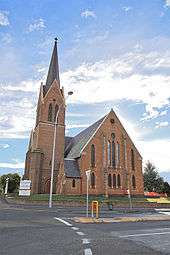
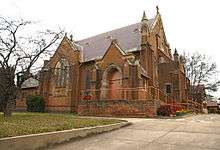
- St Joseph's and St Mary's Catholic Churches
- Holy Trinity Anglican Church
- Orange Uniting Churches
- Orange Baptist Church
- Orange Presbyterian Church
- St Peter's Lutheran Church
- New Life City Church
- Orange Evangelical Church
- Orange Christian Assembly
- Mountain Hope Church
- Salvation Army
- Orange Seventh-day Adventist Church
- Orange Church of Christ
- Slavic Pentecostal Church
- The Church of Jesus Christ of Latter-Day Saints
Suburbs
The following are listed as the suburbs within Orange City Council, according to the New South Wales Division of Local Government:[14]
- Ammerdown: a residential locality to the north west of Orange on the Mitchell Highway.
- Bletchington: containing mostly residential areas with one school, it is one of the largest residential areas, and it is often split into North Orange and Bletchington. Within the suburb are the Orange Botanic Gardens, the Orange Adventure Playground, and the Waratah Sports Ground.
- Bloomfield: containing farmland, Bloomfield Golf Course, Riverside Mental Institution and Orange Health Service (a major regional hospital) along with the Gosling Creek Reservoir and the Gosling Creek nature reserve.
- Borenore: a locality, 15 km (9 mi) west of Orange, comprising primarily farmland. Also the site of the Australian National Field Days.[15]
- Bowen: containing residential, predominantly public housing, industrial, commercial, Kinross Woloroi School, and government offices, this suburb also has the main road out of Orange to Sydney. It also contains the Orange Showground and the Orange Cemetery.
- Calare: the suburb is located to the west of the CBD. It is mostly a residential area, and contains Calare Public School and Orange High School, and Wentworth Golf Course. It is also commonly split into Calare, Bel-Air and Wentworth Estate and has The Quarry and Towac Park Racecourse. It houses most New Areas of Orange
- Canobolas: this mainly farming and recreation area, contains the Mount Canobolas State recreation area and Mount Canobolas.
- Clifton Grove: containing farmland and large residential blocks, some parts of the estate are down stream from the Suma Park Reservoir and the area also contains the Kinross State Forest.
- Clover Hill: a residential suburb to the north of the CBD.
- Glenroi: a mainly residential area with areas of public housing, along with the Electrolux white goods manufacturing plant. It also contains industrial land in areas surrounding the factory, as well as a more recent industrial area known as Leewood Estate.
- Huntley: a locality south of Orange.
- Lucknow: a small village approximately 9 kilometres (5.6 mi) east of Orange.[16] It is a historic mining town with small residential, small industrial and commercial with most being farmland.
- March: a locality north of Orange.
- Millthorpe: a village south east of Orange. The area constituting a suburb of Orange is constituted of farmland lying to the north west of the village.
- Narrambla: a mainly industrial and farming land area.
- Nashdale: a small but vibrant community located approximately 8 kilometres west of Orange. The community gathers around the local Nashdale Public School and hall. Rich producer of local food and wine.
- Orange: the suburb comprises the central business district of the city, which contains an original grid street plan. The main street of Orange is Summer Street. The CBD can be defined as being the area of the city bounded by Hill, March, Peisley, and Moulder Streets.
- Orange East: beginning on the eastern side of the railway line, Orange East is mostly residential, but contains some light businesses, especially on Summer, Byng, and William Streets.
- Orange South: directly to the south of the CBD, beginning past Moulder Street this area contains Wade Park and the Orange Base Hospital.
- Shadforth: a locality to the east of Orange bypassed by the Mitchell Highway that contains Shadforth Quarry.
- Spring Hill: a village to the south-east of Orange.
- Spring Terrace: a locality and small village located south of Orange, centred on the local primary school.
- Springside: a locality to the south of Orange.
- Suma Park: a lightly populated residential area on the eastern outskirts of Orange. It contains Suma Park Reservoir, Orange's main water supply.
- Summer Hill: a lightly populated residential, industrial, and farmland area on the south eastern outskirts of Orange on the Mitchell Highway.
- Warrendine: a mostly residential area and contains James Sheahan Catholic High School and industrial land. It also has small school farmland and Jack Brabham Park.
Mining
Cadia-Ridgeway Mine is a large open cut gold and copper mine located about 20 kilometres south of Orange, the mine has been developed throughout the 1990s employing several thousand employees with an expected lifespan of several decades. Cadia is the second largest open cut mine in Australia after the Super Pit at Kalgoorlie. Large mineral deposits are also being uncovered from the more recently developed Ridgeway underground mine which is adjacent to the Cadia Mine.
The mine is operated by Newcrest Mining. Cadia-Ridgeway is one of two gold mines Newcrest currently operates in Australia, the other being Telfer in Western Australia. The company also owns and operates the Gosowong Mine in Indonesia and the Lihir mine in Papua New Guinea (both gold mines) amongst others .[17]
Winemaking
The Orange wine region is defined as the area above 600m in the local government areas of Orange, Cabonne and Blayney and can be usefully described as a circle around Orange. The Orange region is good for grape growing and winemaking due to a combination of geology, soils, climate and temperature. Together these factors combine to produce grapes and wine of distinct flavours and colour. The climate perhaps plays the biggest part in giving Orange some distinct natural advantages – the cool temperatures during most of the growing season coupled with dry autumn conditions are ideal for grape growing.[18]
Wineries
|
|
|
|
Wineries that use Orange region grapes in their wines include Brokenwood Wines (Hunter Valley based), Logan (Mudgee), Tamburlaine (Hunter Valley), Gartelmann (Hunter Valley), Windowrie (Central Ranges), Eloquesta Wines (Mudgee) and Lowe Wines (Mudgee). In 2007, South Australian based Penfolds winery released the 2007 Penfolds Bin 311 Orange Region Chardonnay.[19]
Media
Orange is served by several radio stations, including 105.1 2GZFM, 105.9 Star FM, FM107.5 Orange Community Radio, 103.5 Rhema FM, HIT Country 88 FM and 2EL 1089AM – a commercial station that gets most of its programming from 2SM in Sydney. The Australian Broadcasting Corporation (ABC) also broadcasts from four radio stations in Orange including ABC Local Radio (2CR) on 549AM and three national networks – ABC Classic FM on 102.7 FM, ABC Radio National on 104.3 FM, and Triple J on 101.9 FM.
The city receives five network television stations – Prime7 (a Seven Network affiliate), WIN TV (a Network 10 affiliate), Southern Cross Nine (a Nine Network affiliate), ABC TV and SBS.
Of the three main commercial networks:
- Prime7 News produces a half-hour local news bulletin for the Central West, airing each weeknight at 6pm. It is produced from local newsrooms in Orange and Dubbo and broadcast from studios in Canberra.
- Southern Cross Nine airs a regional New South Wales edition of Nine News from Sydney each weeknight at 6pm, featuring opt-outs for the Central West.
- WIN Television aired a half-hour local bulletin until the closure of its Orange newsroom in June 2019.[20][21] The station now produces short news updates throughout the day from its Wollongong studios.
Subscription television service Foxtel is available in Orange and the surrounding region via satellite.
The local newspapers are the Central Western Daily, the Midstate Observer and Orange City Life.
Clubs and entertainment
Water resources
Orange has several water sources used for domestic consumption, both currently in use and formerly used. Currently Suma Park Dam and Spring Creek Reservoir are used for domestic water consumption. Two other dams, Lake Canobolas and Gosling Creek Reservoir, were previously used for domestic water consumption; however, they are now used for recreational purposes. The city is currently on Level 5 water restrictions. Orange City Council is undertaking a number of strategies to supplement its supply, including stormwater harvesting.
The first batch of harvested stormwater was released into Suma Park Dam on 21 April 2009. The harvested stormwater was tested by Analytical Laboratory Services, an independent laboratory based in Sydney. ALS tested for 90 potential pollutants. The tests revealed that the water quality met all targets. The first batch contained 14 megalitres. It is believed to be an Australian first for harvesting stormwater for potable use. The hardware is in place, operating rules have been developed and environmental factors and impacts on downstream users have been considered. A three-month trial will ensure all these elements are working together to ensure high water quality and environmental standards are met. There are several phases involved in the commissioning period. The hardware, which includes three separate pumping stations, creek flow monitoring points and advanced electronics including fibre optic cables, will undergo further operating tests. The other elements of the scheme include a weir on Blackmans Swamp Creek, which creates a 3 megalitre pool and the site for the first pump station, a 200 megalitre dam and two 17 megalitre batching ponds. The pumps on the creek transfer stormwater to the 200 megalitre dam at a rate of up to 450 litres per second and are designed to rapidly extract peak storm flows from the creek. The operating rules require that a base flow immediately downstream in the creek must be maintained. The creek flow monitoring points ensure these standards are met. The monitoring station also measures when harvesting can commence. The trigger is flows passing the monitor in Blackmans Swamp Creek exceeding 1000 litres per second.
The local mine, Cadia-Ridgeway Mine, uses the city's treated effluent to supplement its water supply.
Orange is currently planning to implement a pipeline from the Macquarie river to boost the town water supply. This is hotly debated, and researchers believe that it will endanger threatened wetland areas.[22]
Transport
Roads
Orange is situated on the Mitchell Highway, linking the city to Molong, Wellington, Dubbo and Bourke to the north west, and to Bathurst to the east and from there to Sydney via the Great Western Highway (260 km or 160 mi). Due west are Parkes (100 km or 62 mi) and Forbes (125 km or 78 mi), which is midway along the Newell Highway, running from Brisbane, Queensland to Melbourne, Victoria. In 2007 a bypass road, known as the northern distributor road, was opened for use after decades of planning.
Public transport
Orange Buslines operate a number of routes within the city and a service to the neighbouring city of Bathurst. Newman's Bus Service operates route two on weekdays to Blayney. Australia Wide Coaches operate a daily coach service to Sydney.
NSW TrainLink operate several coach services with connecting train services from Lithgow to Sydney, as well as a less frequent coach service to Cootamundra for connection to Melbourne.
Air
Orange is also serviced by a regional-class airport, Orange Airport, located approximately 15 km to the south of the city, in an area known as Huntley.
Railways
Orange has two railway stations. The main station, on the Main Western Line to Bourke, was opened in 1877[23] and is served by the daily NSW TrainLink Central West XPT service between Sydney and Dubbo and the weekly Outback Xplorer service between Sydney and Broken Hill. A smaller station, opened in 1970,[24] known as Orange East Fork, lies on the branch line to Broken Hill and is served by the weekly Indian Pacific service to Perth.
Sister cities
Orange is a sister city to:[25]


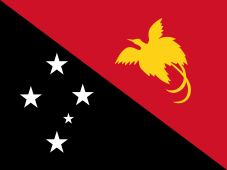

Notable residents
Architecture
- John Andrews AO - internationally acclaimed architect resides in the city[26]
Business
- James Dalton (1834–1919), an early Australian merchant, pastoralist, and Roman Catholic lay leader, a key figure in the early development of Orange and district[27]
Film and television
- Billy Bevan (1887–1957), actor, born William Bevan Harris in Orange.
- Mark Furze, a television actor and singer, born in Orange in 1986.
- Elizabeth Lackey, an actress and model, attended Orange High School in the 1980s.
Food and hospitality
- Kate Bracks, winner of the third series of MasterChef Australia, from Orange[28]
Medicine
- Janet Carr, physiotherapist and academic, raised in Orange[29]
- Anna Windsor (born 1976), Multi Olympian and Commonwealth Games swimmer. Medical Doctor based in Orange.
Music and creative arts
- Murray Cook, a vocalist, songwriter and guitarist; best known as one of the members of The Wiggles, grew up in Orange[30]
- Susan, Crown Princess of Albania (1941–2004), the wife of Leka, Crown Prince of Albania, educated and taught art at Presbyterian Ladies College, Orange[31]
Poetry
- Banjo Paterson (1864–1941), poet, born near Orange[32]
- Kenneth Slessor (1901–1971), poet, born in Orange[33]
Police
- Frederick Hanson (1914–1980), former Commissioner of New South Wales Police, born in Orange[34]
Politics
- Sir Charles Cutler (1918–2006), a former politician including holding office for 28 years as an elected Member for Orange, and former Deputy Premier[35]
- J. J. Dalton (1861–1924), the second son of James Dalton, the first Australian born member of the British Parliament, born in Orange
- Tim Gartrell, former National Secretary of the Australian Labor Party and now Chief Executive of GenerationOne, born in Orange in 1970[36]
- Sir Neville Howse, VC (1863–1930), the first Australian recipient of the Victoria Cross, a physician living in Orange, twice elected Mayor, and later federal politician[37]
Sports
marianne Murphy Australian netballer #111 diamond Australian team
- Robbie Abel, professional rugby union footballer, born in Orange in 1989
- Jason Belmonte, professional tenpin bowler, born in Orange in 1983[38]
- Darren Britt, former professional rugby league footballer, born in Orange in 1969
- Adam Clune, professional rugby league player, born in Orange in 1995
- Andrew Dawes, Australian Paralympic coach, born in Orange.
- David Lyons, professional rugby union player, born in Orange in 1980[39]
- Phoebe Litchfield, Australian cricketer, lives in Orange.
- James Maloney, professional rugby league player, born in Orange in 1986[40]
- Daniel Mortimer, professional rugby league player, born in Orange in 1989[41]
- Peter Mortimer, father of Daniel Mortimer, a former professional rugby league footballer and manager, now news reporter and winery owner, living in the Orange region[42]
- Lucas Parsons, professional golfer, born in Orange in 1969[43]
- Jack Wighton, professional rugby league player, born in Orange in 1993
- Jo Hunter (nee Garey), Australian cricketer 1995, lives in Orange.[44]
Attractions
Orange has many attractions. There are bush walking trails in Orange including; Spring Glade Walking Track, Cook Park Heritage Walk, Summits Walking Tracks, Nangar National Park and Mullion Range State Conservation Area.[45] Borenore Caves is a series of limestone caves. Duntryleague Golf Club and Clubhouse, Mount Canobolas and Federal Falls in the Mount Canobolas State Conservation Area, Lake Canobolas, Gnoo Blas Motor Racing Circuit, the historic centre of Orange and the Orange Botanic Gardens are also near the town.
Heritage listings
Orange has a number of heritage-listed sites, including:
- 215-223 Anson Street: Uniting Church and Kindergarten Hall, Orange[48]
- 3-25 Bathurst Road: Bowen Terrace[49]
- 84 Byng Street: Union Bank of Australia building, Orange[50]
- Forest Road: Bloomfield Hospital, Orange[51]
- Peisley Street: Orange railway station, New South Wales[52]
- 24-26 Summer Street: Cook Park, Orange[53]
- 29 Summer Street: Berrilea[54]
- 222 Summer Street: Orange Post Office[55]
- Woodward Street: Duntryleague[56]
Historic buildings
- Anson House
- Australia Cinema
- Bowen Terrace
- Centrepoint Arcade Building
- Cook Park Greenhouses and caretakers houses
- Dalton Bros Buildings (Myer Building: facade only remains)
- Hotel Canobolas (a fine example of Art-Deco style, erected 1939)
- Hotel Orange
- Holy Trinity Anglican Church
- Memorial Hall
- Metropolitan Hotel
- Orange Court House
- Orange Fire Station
- Orange Post Office
- Orange Public School
- Orange Town Hall
- Royal Hotel
- Saint Joseph's Church
- Scout Hall
- The former Strand Theatre
- Wyoming Court
Historic houses
- Strathroy Manor
- Duntryleague House
- Kangaroobie Mansion
- Croagh Patrick
- Woloroi House
- Galbally
- Killenny
- Mena
- Ammerdown House
- Glenroi House (no longer standing, demolished for McDonald's)
Gallery
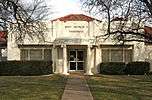
Community Health Centre, Kite Street 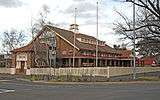
Former Department of Lands Building, Kite Street 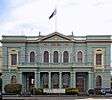
Former Town Hall, Anson Street 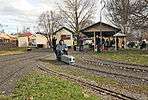
Miniature Railway, Matthews Park 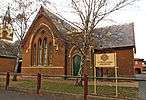
Sir Henry Parkes Arts Centre, Sale Street 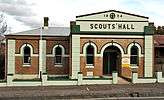
Scouts' Hall, Kite Street 
Mount Canobolas from the Pinnacle 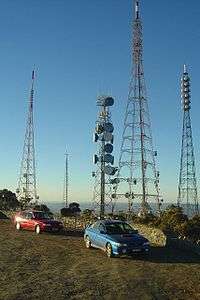
Transmission towers atop Mount Canobolas 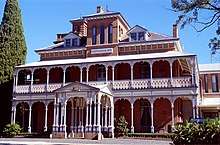 Duntryleague Wedding and Function Centre, Woodward Street
Duntryleague Wedding and Function Centre, Woodward Street
See also
References
- "3218.0 – Regional Population Growth, Australia, 2017-18: Population Estimates by Significant Urban Area, 2008 to 2018". Australian Bureau of Statistics. Australian Bureau of Statistics. 27 March 2019. Retrieved 25 October 2019. Estimated resident population, 30 June 2018.
- "Climate statistics for Orange Post Office". Australian Bureau of Meteorology. Australian Government. Retrieved 21 February 2009.
- "Great Circle Distance between ORANGE and SYDNEY". Geosciences Australia website. Commonwealth of Australia. Retrieved 28 August 2011.
- Graham Howard & Stewart Wilson (1986). "1960: Let the race begin". Australian Touring Car Championship, 25 Fabulous Years. Gordon, NSW: R&T Publishing. pp. 14–26. ISBN 0-9590378-2-9.
- Greaves, Bernard. "Blackman, James (1792–1868)". Australian Dictionary of Biography. National Centre of Biography, Australian National University. Retrieved 9 December 2013.
- "PLACE NAMES". The Australian Women's Weekly. National Library of Australia. 13 May 1964. p. 61. Retrieved 23 February 2011.
- "Orange Region Terroir". Wines of Orange. 2010.
- "Climate statistics for Orange Airport". Bureau of Meteorology. Commonwealth of Australia. 2 June 2011. Retrieved 7 June 2011.
- "Bureau of Meteorology – Summary statistics WOLLONGONG UNIVERSITY". Australian Bureau of Meteorology. Retrieved 20 November 2014.
- "Climate statistics for Australian locations". Bureau of Meteorology. Retrieved 15 November 2013.
- "Orange Wine Region". WineCompanion.com.au. Retrieved 25 January 2014.
- "Monthly mean temperatures: Orange Agricultural Institute". Climate statistics for Australian locations. Bureau of Meteorology. Retrieved 26 September 2017.
- "Monthly rainfall: Orange Agricultural Institute". Climate statistics for Australian locations. Bureau of Meteorology. Retrieved 26 September 2017.
- "Suburb Search: Orange City Council". Local Council Boundaries. Division of Local Government. Retrieved 13 May 2011.
- "Event information". Australian National Field Days. Retrieved 13 May 2011.
- "Lucknow". Geographical Names Register (GNR) of NSW. Geographical Names Board of New South Wales. Retrieved 12 May 2011.

- http://www.centralwesterndaily.com.au/news/local/news/general/stink-over-effluent/1557992.aspx
- http://www.winesoforange.com.au/
- "Bin 311 Orange Chardonnay 2007" (PDF). Penfolds. Retrieved 4 June 2016.
- King, Rosie (20 June 2019). "WIN News to cut four commercial TV newsrooms in Orange, Wagga Wagga, Albury and Bundaberg". ABC News. Australian Broadcasting Corporation. Retrieved 24 June 2019.
- Duke, Jennifer (19 June 2019). "WIN shuts down five newsrooms as regional broadcasters struggle". The Sydney Morning Herald. Sydney. Retrieved 24 June 2019.
- Cubby, Ben, Pipeline plan puts protected wetlands in peril, say researchers
- "Orange railway station". nswrail.net. Retrieved 7 April 2008.
- "Orange East Fork Platform". nswrail.net. Retrieved 7 April 2008.
- "Sister Cities". orange.nsw.gov.au. Orange City Council. Retrieved 19 May 2020.
- https://www.centralwesterndaily.com.au/story/4687429/architects-famous-tower-acclaimed-at-canadian-awards/
- Rutledge, Martha. "Dalton, James (1834–1919)". Australian Dictionary of Biography. National Centre of Biography, Australian National University. Retrieved 15 January 2012.
- Byrnes, Holly (8 August 2011). "Kate Bracks of Orange in NSW wins MasterChef in 2011". The Daily Telegraph. Australia. Retrieved 8 August 2011.
- McDonald, Tim (26 March 2015). "Physiotherapist and academic Janet Carr transformed rehabilitation practice". The Sydney Morning Herald. Retrieved 26 November 2015.
- Hume, Anika (16 November 2011). "The Wiggles come to Mudgee". Mudgee Guardian. Retrieved 15 January 2012.
- Stephens, Tony (19 July 2004). "Would-be Queen Susan dies uncrowned". The Sydney Morning Herald. Retrieved 15 January 2012.
- Semmler, Clement. "Paterson, Andrew Barton (Banjo) (1864–1941)". Australian Dictionary of Biography. National Centre of Biography, Australian National University. Retrieved 15 January 2012.
- Haskell, Dennis. "Slessor, Kenneth Adolf (1901–1971)". Australian Dictionary of Biography. National Centre of Biography, Australian National University. Retrieved 15 January 2012.
- Swanton, Bruce. "Hanson, Frederick John (1914–1980)". Australian Dictionary of Biography. National Centre of Biography, Australian National University. Retrieved 15 January 2012.
- "Former deputy premier Cutler dead". The Sydney Morning Herald. 24 September 2006. Retrieved 12 February 2009.
- Wainwright, Robert (1 December 2007). "Don't let this fresh face fool you". The Sydney Morning Herald. Retrieved 15 January 2012.
- Hill, A. J. "Howse, Sir Neville Reginald (1863–1930)". Australian Dictionary of Biography. National Centre of Biography, Australian National University. Retrieved 15 January 2012.
- "Jason Belmonte: player profile". Professional Bowlers Association. 2011. Retrieved 7 January 2012.
- "Australia: Players & Officials: David Lyons". ESPN Scrum. 2011. Retrieved 16 January 2012.
- "James Maloney profile". Television New Zealand. 7 August 2009. Retrieved 6 October 2011.
- Ritchie, Dean (6 August 2009). "Eels send Daniel Mortimer back to family vineyard in Orange to re-charge". The Daily Telegraph. Australia. Retrieved 16 January 2012.
- "About us". Mortimers of Orange. 2010. Archived from the original on 21 March 2012. Retrieved 16 January 2012.
- "Lucas John Kendall Parsons - Golf Champion". Orange City Council. Archived from the original on 19 July 2008. Retrieved 24 July 2009.
- https://www.centralwesterndaily.com.au/story/6566867/faces-of-orange-the-tireless-volunteer-you-might-not-know-made-orange-cricket-history/
- "Orange Tourism". 16 May 2017. Retrieved 16 May 2017.
- "Goldseekers Orienteering Club".
- http://www.wentworthgolfclub.com.au
- "Uniting Church & Kindergarten Hall". New South Wales State Heritage Register. Office of Environment and Heritage. H00419. Retrieved 18 May 2018.
- "Bowen Terrace". New South Wales State Heritage Register. Office of Environment and Heritage. H00013. Retrieved 18 May 2018.
- "Union Bank of Australia (former)". New South Wales State Heritage Register. Office of Environment and Heritage. H00230. Retrieved 18 May 2018.
- "Bloomfield Hospital". New South Wales State Heritage Register. Office of Environment and Heritage. H01745. Retrieved 18 May 2018.
- "Orange Railway Station and yard group". New South Wales State Heritage Register. Office of Environment and Heritage. H01218. Retrieved 18 May 2018.
- "Cook Park". New South Wales State Heritage Register. Office of Environment and Heritage. H01998. Retrieved 18 February 2020.
- "Berrilea". New South Wales State Heritage Register. Office of Environment and Heritage. H00361. Retrieved 18 May 2018.
- "Orange Post Office". New South Wales State Heritage Register. Office of Environment and Heritage. H01416. Retrieved 18 May 2018.
- "Duntryleague with Lodge, Park, Gates, Stables". New South Wales State Heritage Register. Office of Environment and Heritage. H00318. Retrieved 18 May 2018.
External links
| Wikimedia Commons has media related to Orange, New South Wales. |
| Wikivoyage has a travel guide for Orange (New South Wales). |
- Orange City Council
- from the Australian Bureau of Statistics
- New South Wales Department of Primary Industries
- Collection of 18 images of Orange in 1996 – National Library of Australia
